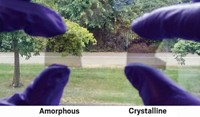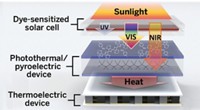Advertisement
Grab your lab coat. Let's get started
Welcome!
Welcome!
Create an account below to get 6 C&EN articles per month, receive newsletters and more - all free.
It seems this is your first time logging in online. Please enter the following information to continue.
As an ACS member you automatically get access to this site. All we need is few more details to create your reading experience.
Not you? Sign in with a different account.
Not you? Sign in with a different account.
ERROR 1
ERROR 1
ERROR 2
ERROR 2
ERROR 2
ERROR 2
ERROR 2
Password and Confirm password must match.
If you have an ACS member number, please enter it here so we can link this account to your membership. (optional)
ERROR 2
ACS values your privacy. By submitting your information, you are gaining access to C&EN and subscribing to our weekly newsletter. We use the information you provide to make your reading experience better, and we will never sell your data to third party members.
Materials
A smart window powers itself
A superthin photovoltaic cell generates enough electricity to switch a liquid-crystal window from cloudy to clear
by Prachi Patel
December 14, 2016

Windows that go from see-through to cloudy at the flip of a switch can provide privacy and help buildings stay cool on sunny days. Such smart glass, while expensive, is starting to find its way into airplanes, cars, and houses. Now, by integrating a rudimentary solar cell into this switchable glass, researchers have made a smart window that can power itself (ACS Photonics 2016, DOI: 10.1021/acsphotonics.6b00518).
Smart glass typically uses materials that switch when a voltage is applied—either electrochromic materials such as tungsten oxide that change opacity, or liquid crystals: When a voltage is applied to a liquid crystal, the molecules go from being randomly oriented—and thus blocking light—to becoming aligned and letting light pass. The electricity needed to power this change in orientation ordinarily would come from an external source, such as a building’s wiring or a car’s battery.
Jeremy N. Munday and his colleagues at the University of Maryland wanted to make a smart window that powers itself, so they incorporated a photovoltaic layer made of amorphous silicon into a liquid-crystal switchable glass. “The amorphous silicon absorbs some of the light and converts it into power to control the window switching,” Munday says.
To make the window, the team mixed tiny droplets of liquid crystals in a polymer and sandwiched a 50-µm-thick layer of this material between two transparent indium tin oxide (ITO) electrodes coated on thin glass sheets. The amorphous silicon layer sits between the ITO layer and the glass sheet that faces the sun.
When the window is turned on during the day, the solar cell generates enough power to align the liquid-crystal molecules and make the glass transparent. When the window is turned off, with no voltage across it, the liquid crystal loses its orientation and scatters light, so the glass appears milky white.
The technology is only a proof of concept. The researchers measured how much light the silicon absorbs and calculated the power that it would generate, but the light-absorbing silicon is not part of a fully functional solar cell. That will require an additional charge-transporting layer between the silicon layer and the glass. Such a layer could affect the transparency of the window and the absorption of the solar cell, so the researchers now face the challenge of finding the right material and tweaking their design.
Still, their measurements show that the switchable window needs less than 1 mW/cm2 to operate, an amount that a 13-nm-thick amorphous-silicon layer could generate under typical sunlight intensity. In the window’s off state, the solar cell could potentially produce enough power for other small electronic devices.
“This is nice work,” says Richard R. Lunt, a chemical engineering professor at Michigan State University. “There is significant interest in these types of approaches to smart and functional windows.” The technology will be important if the researchers can show that it lasts for a long time, works well over varying light intensity, and has minimal aesthetic impact over large areas, he adds.





Join the conversation
Contact the reporter
Submit a Letter to the Editor for publication
Engage with us on Twitter